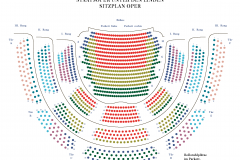Dido and Aeneas
November 2025 | ||||||
|---|---|---|---|---|---|---|
Mo | Tu | We | Th | Fr | Sa | Su |
Dido and Aeneas
Opera in a prologue and three acts (1689)
Music by Henry Purcell
Text by Nahum Tate based on Book IV of Virgil’s "Aeneid"
Duration: approx. 1 hour 45 minutes (without interval)
Language: English, with German and English surtitles
Recommended age: 10 years and older
The setting is Carthage, in ancient times: the hero Aeneas flees from burning Troy and arrives in North Africa via the Mediterranean Sea with his fleet of ships, where he meets the beautiful queen Dido. They are lovestruck – and yet fail to bond because of fate’s intervention. Aeneas continues on his journey to form a new kingdom in Italy, while the abandoned Dido is left no alternative but to stay.
Henry Purcell composed his one "genuine" opera in 1689, a work that stood out for its musical ingenuity. Virgil’s epic story of the hero and Carthaginian queen told in Aeneid found its echo in his equally vivid music. Human passions are candidly unveiled – both their joys and excitements as well as their hardships and worries, all the way to deepest despair at the inexorability of divine will. Dido’s famous lament, with which she ends her life, and the opera draws to a close, and where an entire world is evoked in a few words, demonstrates Purcell’s extraordinary expressiveness. But his skill, too, in writing rhythmically concise dance movements and melodic choruses sealed the composer’s reputation among his contemporaries and ensured the admiration of a truly exceptional composer for posterity. Song, performance and dance combine to create a special form of opera.
Program and cast
Musical Director: Christopher Moulds
Director, choreography: Sasha Waltz
Musikalische Rekonstruktion: Attilio Cremonesi
Set Design: Thomas Schenk, Sasha Waltz
Costumes: Christine Birkle
Light: Thilo Reuther
Dramaturgy: Jochen Sandig, Yoreme Waltz
Dido: Natalia Skrycka
Aeneas: Gyula Orendt
Belinda: Aphrodite Patoulidou
Second Woman: Jingjing Xu
Sorceress: Hanseong Yun
First Witch, A Sailor: Junho Hwang
Second Witch, Spirit: Álvaro Diana
Tänzer:innen der Compagnie Sasha Waltz & Guests, Vocalconsort Berlin, Akademie für Alte Musik Berlin
State Opera Unter den Linden
Staatsoper Unter den Linden is one of Berlin's most prestigious opera houses, with a rich history and significant cultural impact.
History:
The Staatsoper Unter den Linden was originally built between 1741 and 1743, under the direction of architect Georg Wenzeslaus von Knobelsdorff. It was commissioned by Frederick II of Prussia and was initially named the Königliche Oper (Royal Opera). The opera house has undergone several renovations and reconstructions, notably after World War II damage. It reopened in 1984, following a major renovation.
Construction:
The original design was characterized by its Baroque style, featuring an elegant façade and a grand entrance. The building was reconstructed in the 1950s and 1980s, maintaining its classical exterior while modernizing the interior. The façade features a classic portico with six Corinthian columns and a prominent central pediment.
Interior:
The interior is known for its opulent and classical design. The auditorium is renowned for its acoustics and grandeur, with luxurious velvet seats and elaborate decorations. The stage and seating areas have been updated to meet modern performance standards while preserving historical aesthetics.
Concerts and Performances:
The Staatsoper Unter den Linden hosts a variety of performances, including operas, orchestral concerts, and ballet. It is home to the Staatskapelle Berlin, one of Germany's leading orchestras. The opera house is celebrated for its high-quality productions and its role in Berlin’s vibrant cultural scene.
JOURNEY
The Staatsoper Unter den Linden has completely barrier-free access due to its excellent public transport connections.
ADDRESS: Unter den Linden 7; 10117 Berlin
SUBURBAN RAILWAY
S+U Friedrichstraße (S1, S2, S5, S7, S25, S75)
SUBWAY
Hausvogteiplatz (U2)
Museumsinsel (U5)
Stadtmitte (U2, U6)
Unter den Linden (U5, U6)
BUS
Staatsoper (100, 245, 300)
Unter den Linden/Friedrichstraße (100, 147, 245, 300, N6)
PARKING
Q-PARK parking garage Unter den Linden/Staatsoper
Bebelplatz, 10117 Berlin
There are five electric charging stations in the parking garage. Further information can be found here.
The underground car park on Bebelplatz offers disabled parking spaces and direct access to the opera house. On entering the car park between 5.30pm and 11.30pm, the maximum parking fee is €7. To use this tariff, enter your parking ticket in one of the pay machines and the message »Theatertarif« will appear on the display. Please note that it is not possible to use the tariff if you enter the car park before 5.30pm. so it will not be shown on the display. TIP: If you pay the theatre tariff at the pay machine before the event, you can avoid unnecessary waiting after the show.

 EN
EN DE
DE IT
IT FR
FR ES
ES RU
RU JP
JP RO
RO
 Seating plan
Seating plan 